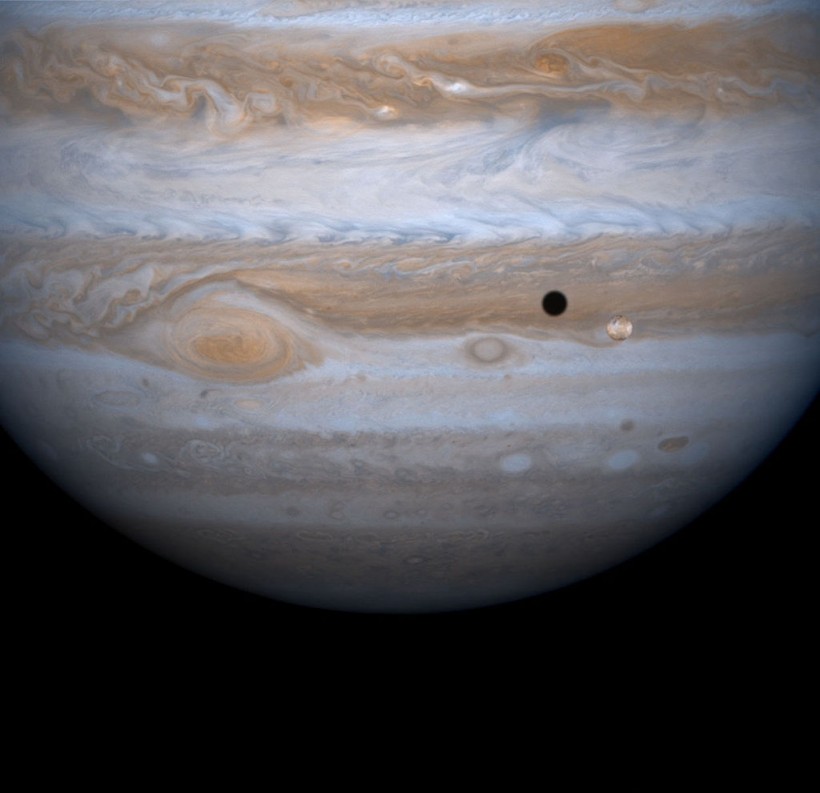Titan, Saturn's giant moon, is remarkably familiar to Earth in many aspects compared to most other places in the Solar System.
Titan is the only moon in the Solar System with a rich atmosphere, allowing for a variety of quasi-Earth-like weather events, including methane rain, which feeds rivers and, in turn, lakes.
Researchers published their study, "The Role of Seasonal Sediment Transport and Sintering in Shaping Titan's Landscapes: A Hypothesis," in Geophysical Research Letters.

383787 01: The entire body of Moon-sized Io, as it casts a black shadow, is captured here alongside the planet Jupiter in this picture taken by NASA's Cassini spacecraft, December 3, 2000. Jupiter's other moon, Ganymede is larger than the planets Mercury and Pluto and Saturn's largest moon, Titan. Both Ganymede and Titan have greater surface area than the entire Eurasian continent on our planet. Cassini was 26.5 million kilometers (16.5 million miles) from Ganymede when this image was taken. The smallest visible features are about 160 kilometers (about 100 miles) across.
Jupiter Giant Moon Titan's Landscape vs. Earth's Topography
While much of Titan's landscape is vastly different from Earth's, other characteristics of the frozen moon, such as Titan's towering sand dunes, are not so unlike - and yet the presence of these dunes remains a mystery.
Lead study author and planetary geologist Mathieu Lapôtre of Stanford University said per Science Alert that deposits on Saturn's moon are made up of mechanically weak organic granules that are prone to abrasion into dust.
The sediment that makes up dunes on Earth is composed of inorganic silicates, but Titan's sand consists of organic silicates.
Because of the rapid abrasion, the sand particles in Titan's dunes should become finer and more refined with time, finally grinding away to dust.
ALSO READ: Should NASA Prioritize Probing Ice Planet Uranus? Here's What Planetary Scientists Recommend!
This small dust would eventually fly away in the atmosphere, making it impossible to construct cohesive structures such as enormous dunes, which require larger, coarser particles to combine.
How Titan's Surface Features Evolved
Researchers from Stanford University, led by Lapôtre and NASA's Jet Propulsion Laboratory, investigate how Titan's surface features may have evolved like dunes and plains. Per Digital Trends, hydrocarbon dunes are between the rivers covering their frozen surface.
Titan is considered potentially livable because, besides having the solar system's only known large atmosphere, it has a seasonal liquid cycle similar to Earth's, with liquid pouring over the surface and evaporating up into clouds before raining down again. On Titan, however, this cycle happens with liquid methane and ethane rather than water.
The formation of dunes from hydrocarbons that make sand grains is also affected by the yearly cycle. Sands on Earth, on the other hand, are made up of hard silicate grains, but sands on Titan are made up of soft compounds that wear down into fine dust. It was unclear how these substances might coalesce into grains that build dunes that had endured hundreds of thousands of years.
"As winds transport grains, the grains collide with each other and with the surface," Lapôtre explained the problem in a statement.
He went on to say that these collisions tend to reduce grain size over time. However, the researchers missed the growth mechanism to counteract this and allow sand grains to retain a consistent size throughout time.
The solution could be due to a process known as sintering. A collection of small particles binds together to form a solid mass under the influence of heat or pressure. It allows the grains to grow in size, which is counterbalanced by erosion and causes the grains to shrink.
RELATED ARTICLE: Titan's Landscape: Saturn's Largest Moon Similar to Earth, Here's Why
Check out more news and information on Space in Science Times.














